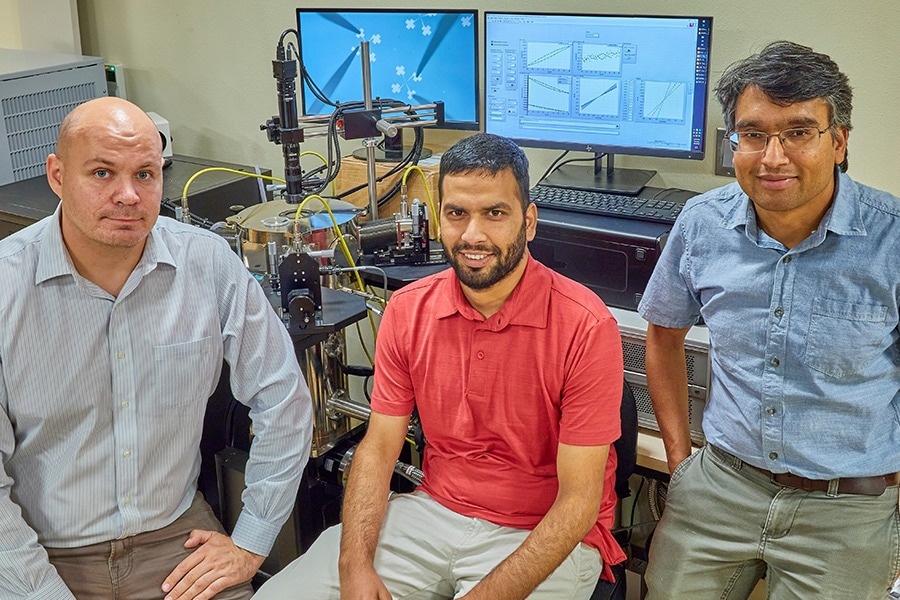In the high-tech industry, Moore’s Law, first coined in the 1960’s, is an observation that the number of transistors in an integrated circuit doubles about every two years. In a nutshell, this means technology continues to get smaller and faster over time. This is why the smartphone you may be reading this on is actually more powerful than the computers NASA used when sending Apollo Missions to the moon 50 years ago.
 Alexey Lipatov (left), Tula Paudel (right) and Khimananda Acharya (center), a Ph.D. student at South Dakota Mines, in a laboratory collaborating on research into the next generation of computer memory. Image Credit: South Dakota Mines
Alexey Lipatov (left), Tula Paudel (right) and Khimananda Acharya (center), a Ph.D. student at South Dakota Mines, in a laboratory collaborating on research into the next generation of computer memory. Image Credit: South Dakota Mines
But everyone recognizes that Moore’s Law has a limit because it’s hard to make computer chips smaller than individual atoms or molecules. It’s widely believed that humanity will reach the limit of Moore’s Law this decade. New research at South Dakota Mines aims to enable what might be close to the final leap in the smallest computers possible by using two-dimensional (2D) layers of material to store computer memory.
2D materials are generally a few atoms thick; graphene is the most well-known example of this type of nanomaterial. Because of South Dakota Mines’ extensive experience in quantum information and science, researchers here were awarded an $800,000 National Science Foundation award to explore special types of 2D materials with unique structural and electrical properties that allow them to act like very small switches or computer memory devices. The results of this research could lead to the development of memory and computer logic devices that surpass current technologies in energy efficiency and versatility.
“Ferroelectric-based memories offer faster write/read speeds, higher endurance, and lower power consumption than conventional memory devices. Bringing this technology to the two-dimensional world would make it more cost-efficient and alleviate storage density limitations”, says Alexey Lipatov, Ph.D., assistant professor in the Department of Chemistry, Biology, and Health Sciences at Mines.
This project also includes a strong focus on education and outreach. The effort involves both undergraduate and graduate students, while providing opportunities for K-12 students and teachers, to learn about nanotechnology. “The broader aim of the project is to inspire and educate the next generation of scientists and engineers. By exposing students to cutting-edge Quantum Information Science and Engineering (QISE) research, this project establishes a foundation for a variety of collaborative QISE activities in the future,” says Lipatov.
This work is parallel to research into new forms of computer memory being pioneered by investigators from South Dakota Mines and the University of Nebraska-Lincoln.
“South Dakota Mines researchers have the expertise and capabilities to advance the work being done in quantum computing,” says Mines President Jim Rankin, Ph.D., P.E. “This funding, along with our participation in the MonArk Quantum Foundry (also funded by NSF), will help advance and improve cyber security. It also provides an opportunity to spin off new businesses and high-tech jobs in South Dakota.”
The project is funded by the NSF’s Office of Integrated Activities (OD/OIA), the Established Program to Stimulate Competitive Research (EPSCoR), and Technology Frontiers Program (TIP/TF).